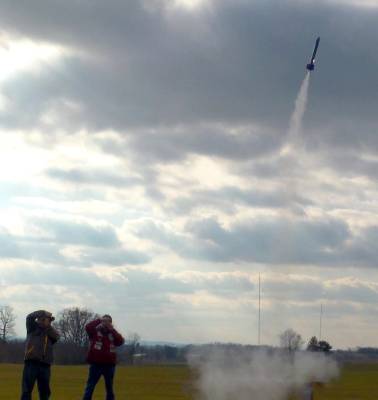The X-15: This is a "Sport-Scale" (not true scale) model of the famous X-15 rocket-powered research plane. This particular kit appears to be newer than other Quest X-15 kits described here: It is a few inches longer, and a recommendation by Quest to only use the A8-3 or A6 motors. (Mine is definitely too heavy to fly on an A8). I chose to paint my particular model gloss blue (not the historically accurate black).
My kit came out pretty heavy as I used a full-sized can of Rustoleum 2X paint trying to get a smooth, glossy finish. Apparently light coats of this paint leave the finish in something like an orange-peel texture, cool but not good for low drag. I discovered heavy, thick coats that would run with normal paints made for a smoother, glossy finish. But by then, there was so much primer and paint on this model that it almost doubled the weight of this kit. In MHO, Rustoleum 2X (from Home Depot) sucks for flying models. I wish I would have used the ridiculously expensive yet lighter Testors stuff at $5 for a tiny 3-oz. can.
The X-15 finally got a payload section addition. This adds another 3 inches to the rockets overall length. This will hold the Altimeter Two, which no longer is at risk of ejection shock damage or loss if the clip fails. The added bulkhead, painted payload tube and padding only adds an additional 13.6 grams of weight to this model.
She flies well and is not affected by the wind much, though I wish I could get her to venture a little closer to the clouds. Actual measurements with an altimeter on board shows this model can go much higher than I estimated, with a C6-3 it reached 437 feet, and traveled at 89 mph. That's enough to have it fly higher than the Great Pyramid of Giza, now that it has eroded about 25 feet.
| Flight Date: | 2012-02-05 |
| Rocket Name: | X-15 |
| Kit Name: | Quest - X-15 {Kit} (2014) |
| Flyer's Name: | Rich DeAngelis |
| Motors: | B6-2 |
| Launch Site: | Penn Manor School Lancaster PA |
| Actual Altitude: | 148 Feet |
On this fairly windy and cold day, I could count on this rocket to fight the winds and fly upwards and not disappoint. I was not sure if the cold would keep the parachute from unfolding or not, as my previous flights this day had all came down under a plastic wad. I was using a B6-2 in case it arched over a lot. This is it's first B6 flight with an altimeter. It burned for 1 second and accelerated to a peak of 6.5 Gs, averaging 2.3 Gs during the boost. After that it reached a speed of 48 mph and coasted for 2.1 seconds to 138 feet, where the ejection charge fired. It coasted for another half second for another ten feet where the parachute opened all the way at 148 feet. It descended at 7mph and landed quite close after 14.7 seconds. It looks like this model could fly with a B6-4 even in strong winds. The large body tube size meant that I could pack the parachute loosely, and I think helped it deploy in the 40-degree temperature.
| Stage | Motor(s) |
|---|---|
| 1 | Estes B6-2 |
 |
 |
